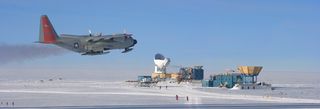
Have Cosmologists Lost Their Minds in the Multiverse? (Op-Ed)

This article was originally published at The Conversation. The publication contributed the article to Live Science's Expert Voices: Op-Ed & Insights.
The recent BICEP2 observations – of swirls in the polarisation of the cosmic microwave background – have been proclaimed as many things, from evidence of the Big Bang and gravitational waves to something strange called the multiverse.
The multiverse theory is that our universe is but one of a vast, variegated ensemble of other universes. We don’t know how many pieces there are to the multiverse but estimates suggest there many be squillions of them.
But (if they exist) there has not been enough time since our cosmic beginning for light from these other universes to reach us. They are beyond our cosmic horizon and thus in principle unobservable.
How, then, can cosmologists say they have seen evidence of them?
Seeing the unobservable
Unobservable entities aren’t necessarily out-of-bounds for science. For example, protons and neutrons are made of subatomic particles called quarks. While they cannot be observed directly, their existence and properties are inferred from the way particles behave when smashed together.
But there is no such luxury with the multiverse. No signals from from other universes have or will ever bother our telescopes.
Sign up for the Live Science daily newsletter now
Get the world’s most fascinating discoveries delivered straight to your inbox.
While there is some debate about what actually makes a scientific theory, we should at least ask if the multiverse theory is testable? Does it make predictions that we can test in a laboratory or with our telescopes?
The answer is yes, but perhaps not as you’d expect. And the exploration of the multiverse theory involves some very complex, and very controversial, ideas.
The mark of the generator
If your multiverse theory generates its universes via some physical process, then that process may leave its fingerprints on this universe. This is what BICEP2 might have seen.

Cosmologists think that in its earliest stages, the universe underwent an extraordinarily rapid expansion, known as inflation. In many versions of inflation, gravitational waves leave an imprint in fossil radiation, recently observed as characteristic swirls in this ancient light; a successful prediction of inflation.
In some versions of inflation, the process that causes our universe to inflate is expected to produce huge numbers of other universes. Evidence for inflation isn’t exactly direct evidence for the multiverse, but it’s a start.
A known generator
We cannot see the creation of other universes, but if we have evidence for the physics that powers the universe generator then we have another piece of the puzzle.
In particular, a multiverse theory that requires only well-tested physics such as gravity and quantum fields is preferable to one that requires new physics, or requires extrapolating known physics to situations where we expect them to break down.
Inflation’s scorecard is mixed: some of the underlying physics is known, some is hypothetical, and some worry that it skirts close to (or perhaps into) the quantum gravity regime, where all tested physical theories break down.
Observing our universe in the ensemble
Let’s think about prediction with a simple example. Alice predicts that a certain factory makes 99% red widgets, 1% blue. Bob predicts the opposite: 99% blue and 1% red.
A packet arrives from the factory and they open it to find a red widget – whose theory is correct? Neither theory is certainly false, but the evidence clearly favours Alice.
A multiverse theory will (by definition) predict the statistical properties of its universes. We can then ask whether our universe is the kind of universe one would expect to observe.
The more unusual our universe is, the more likely it is that a different multiverse theory would better explain our universe. And if our universe is just too weird for the vast majority of multiverse theories, then the whole idea of a multiverse comes under question.
It is thus relevant to ask: how typical is our universe of the set of possible universes?
There is one way in which our universe is highly unusual: it contains life. If our laws of nature were only slightly different then our universe would look and behave quite differently: atoms would fall apart, or the universe would have expanded so fast that stars and galaxies could not form.
Most cosmological scenarios would have left our universe stone-cold dead, devoid of life (as explained in the video below).
Life in a fine-tuned universe.
The multiverse can handle this. The probability of observing a particular type of universe depends on that universe first creating observers. We are not just passive observers, setting up our equipment and taking measurements of the universe at our leisure. We are products of this universe.
While universes with observers may be highly unusual in the entire multiverse, they will obviously be the norm for observed universes. And so, the life-permitting nature of our universe can be counted as a successful prediction of the multiverse. (Prediction in the logical, rather than chronological sense.)
Revenge of the Boltzmann Brains
Or can it? We’ve assumed that the most likely way for a universe to make observers is via suitable laws and biological evolution, as in our universe. Such a universe is probably extremely unusual in the multiverse. But what if just any old universe could get lucky and fluke a few observers?
Quantum mechanics, the same physics that predicts the inflationary fluctuations in the cosmic microwave background, seen by BICEP2, also predicts that there is an extremely tiny probability of a fully-formed brain spontaneously popping out of “empty” space. Given enough time and space this vanishingly improbable event will occur.
While such freak observers, known as Boltzmann Brains, would be massively outnumbered by biological observers in our universe, they could be common in the almost unending time and space of the entire multiverse.
In that case, the fact that we are not that kind of observer is like seeing the red widget – it is evidence against a multiverse theory that says we should expect to be freaky observers. The multiverse is not just testable; it might even fail.
Ifs and buts
At the moment, there are too many ifs and maybes in this story.
Observations do not uniquely favour inflation though the BICEP2 results are an impressive step in this direction. It is a matter of some debate whether inflation naturally generates a multiverse.
Further, many multiverse theories struggle to predict anything, so clearly there is much much more to be done.
But positing the multiverse is not, as claimed by some, the end of science. It may be the start of the biggest scientific adventure of all.
Luke Barnes receives funding from the Australian Research Council.
Geraint Lewis receives funding from the Australian Research Council, including Discovery Projects and a Future Fellowship.
This article was originally published on The Conversation. Read the original article. Follow all of the Expert Voices issues and debates — and become part of the discussion — on Facebook, Twitter and Google +. The views expressed are those of the author and do not necessarily reflect the views of the publisher. This version of the article was originally published on Live Science.












